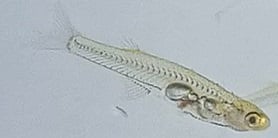Let them eat... bugs! - Kesler Science Weekly Phenomenon and Graph
I have to be honest. For me, the idea of eating bugs is... challenging 😆. But insects have been a dietary staple in some parts of the world for centuries. Entomophagy, or the practice of eating insects, could offer tons of benefits to the environment and food sustainability. Plus, who wouldn't want to add a little more crunch to their lunch?
Check out this graph about the cost in terms of water, food, and emissions for different sources of protein, then check out the details below:
.png?width=600&height=450&name=crickets%20and%20cows(1).png)
Reducing Greenhouse Gas Emissions
According to a study by the Food and Agriculture Organization (FAO) of the United Nations, crickets produce 80 times less methane than cattle per unit of body weight. That's a huge reduction in greenhouse gases!
Lowering Water Usage
Beef production demands approximately 2400 gallons of water per pound of meat. 💧 Insects, on the other hand, require significantly less water. Producing a pound of crickets needs only about 0.45 gallons of water!
Efficient Feed Conversion
Insects are remarkably efficient at converting feed into edible body mass. Cattle, pigs, and chickens convert about 10-15% of what they consume into body weight. Insects can convert 30-40% of their feed into biomass!
To put it another way, crickets need about 2.1 pounds of feed to produce 1 pound of body mass, compared to the 25 pounds of feed required by cattle to produce the same amount of meat.
Reducing Land Use
Livestock require tons of farmland, not just for living on, but for growing their food. Insects require far less space -they can be raised vertically in urban settings! Imagine: fields of crickets instead of fields of cows. 😆
Alleviating Pressure on Wild Fish Populations
Insects can help feed livestock, too! Fishmeal is a common ingredient in animal feed and comes from wild-caught fish. The demand for fishmeal is so high that overfishing can be a real problem. Protein from insects like black soldier fly larvae can be a good substitute, which helps lighten the pressure on wild fish populations.
Economic Considerations
Can you imagine seeing a prize cricket next to other livestock at the county fair? Insect farming is a new opportunity for small-scale farmers. The startup costs and resource requirements are far less than traditional farming. Plus, the global market for edible insects is projected to grow. Just imagine: a future where kids run lemonade and roasted ant stands on the corner. 🍋🐜
Here are a couple questions I might ask my students about this topic:
💡 If you could only see the graph and not the details under it, how could you still tell that cows are the least efficient at turning their food into protein?
💡 Looking at the graph, how could you guess that cows require the most land to support them?
💡 Of the benefits listed in the blog - reduced greenhouse gases, feed, water, land use, fishing, and better economics, which could you NOT likely deduce from the graph?
The next time you're hungry for a burger, are you going to try a bug-er instead? 🍔🐜
- Chris



